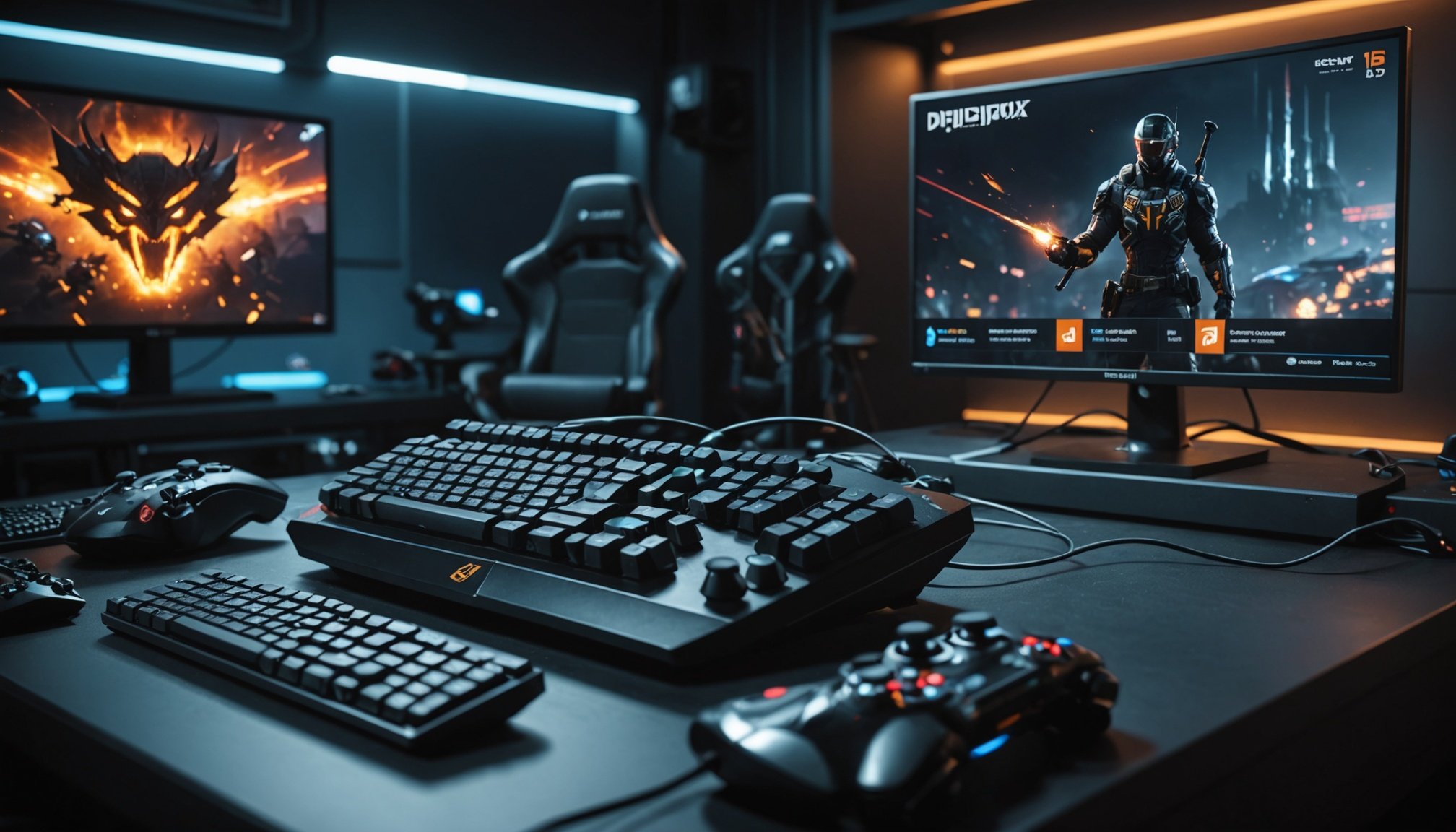Ultimate Strategies to Minimize Input Lag for Superior Competitive Console Gaming Performance
Understanding Input Lag: The Enemy of Gamers
Input lag, the delay between your actions and the game’s response, is a critical issue that can significantly impact your gaming experience. Whether you’re a casual gamer or a competitive player, understanding and minimizing input lag is essential for optimal performance.
Main Reasons for Input Lag
To tackle input lag effectively, it’s crucial to identify its sources. Here are the key factors that contribute to input lag on consoles like the Xbox Series S:
Have you seen this : Mastering Stunning Fire Effects for Action Games: Pro Tips for Captivating Visuals!
| Factor | Impact on Input Lag |
|---|---|
| Display Response Time | Lower response times reduce input lag; higher response times increase it. |
| Wireless Controller Latency | Higher latency results in a delayed player response. |
| Console Performance | Older models may experience more significant input lag issues. |
| Game Optimisation | Better optimised games yield quicker responses for players. |
| HDMI Quality | Higher quality cables minimise connection-related input lag. |
Optimizing Your Display for Low Input Lag
The display you use is one of the most critical components in reducing input lag. Here’s how you can optimize your display settings:
Using a High-Response Display
A high-response display is vital for fast-paced games. Look for a monitor or TV with a response time as low as 1ms. This ensures that the display reacts quickly to your inputs, reducing the noticeable delay.
In the same genre : Ultimate Guide to Crafting Lifelike Sand and Desert Environments: Pro Strategies for Adventure Game Creators
### Example of High-Response Displays
- **Gaming Monitors:** Monitors specifically designed for gaming often have response times of 1ms or 2ms. These monitors are optimized to handle fast-paced games without introducing significant lag.
- **Gaming TVs:** Some modern TVs, especially those with HDMI 2.1, offer low input lag and high refresh rates, making them suitable for console gaming.
Adjusting Display Settings
Adjusting your display settings can also help in reducing input lag:
### Display Settings Adjustments
- **Refresh Rate:** Ensure your display is set to a high refresh rate, such as 120Hz or 240Hz, to match the frame rate of your game.
- **Resolution:** Lowering the resolution can sometimes help in reducing the load on your console, but it may compromise visual quality.
- **Motion Blur and Other Effects:** Disable motion blur and other visual effects that can introduce additional processing time and lag[1][5].
### Reducing Wireless Controller Latency
Wireless controllers can introduce latency, but there are ways to minimize it:
#### Using Wired Connections
Using a wired connection for your controller can significantly reduce latency. If a wired connection is not feasible, ensure you are using a high-quality wireless controller with minimal latency.
#### Reducing Wireless Interference
Wireless interference can also cause delays. Place your console in an area with minimal obstructions and turn off nearby wireless devices to improve your connection.
### Optimizing Console and Game Performance
The performance of your console and the optimization of the game itself play crucial roles in minimizing input lag.
#### Keeping Your Console Updated
Regular software updates from Microsoft can improve the performance of your Xbox Series S, reducing input lag. Ensure your console is always up to date with the latest software patches[1].
#### Game Optimisation
Games that are well-optimized for your console will respond faster to your inputs. Look for games that have been specifically tuned for the Xbox Series S, and keep your games updated with the latest patches.
### Utilizing Quality HDMI Cables
The quality of your HDMI cable can also impact input lag. Here’s why it matters:
#### High-Quality HDMI Cables
Using a high-quality HDMI cable ensures quick and clear signal transfer to your screen. This avoids problems with picture quality and speed, making your gameplay smoother.
markdown
Benefits of High-Quality HDMI Cables
- Fast Signal Transfer: High-quality cables ensure that the signal is transferred quickly, reducing any delays.
- Clear Picture Quality: They maintain the picture quality, avoiding any distortions or lag that could affect your gaming experience[1].
### Additional Tips for Optimising Gameplay
Besides the hardware and software optimizations, here are some additional strategies to enhance your gaming performance:
#### Choosing Game Modes for Performance
Many games offer modes that boost speed and frame rates. Using these modes, especially in fast-paced scenes, can make games run smoother and respond faster to your inputs.
#### Leveraging NVIDIA Reflex Low Latency
For gamers using NVIDIA graphics cards, NVIDIA Reflex Low Latency can significantly improve response times. This technology keeps the GPU buffer clear, ensuring the most up-to-date frame is always rendered, reducing the delay between your actions and the game's response[3].
How NVIDIA Reflex Works
- Clear GPU Buffer: Reflex ensures the GPU always renders the most recent frame, reducing the delay.
- Low Latency Mode: Enable Reflex Low Latency Mode in your game settings and the NVIDIA Control Panel for optimal performance.
- Reflex Latency Analyzer: Use this tool to identify bottlenecks in your system and further optimize your hardware for peak performance[3].
#### Turning Off Unnecessary Features
Turning off unnecessary features like motion blur, ambient occlusion, and other visual effects can help reduce the load on your console and minimize input lag.
Common Features to Disable
- Motion Blur: This effect can introduce additional processing time and lag.
- Ambient Occlusion: While it enhances graphics, it can burden your system and introduce lag.
- Auto Keystone Correction: On projectors, turning off such features can minimize signal processing delays[3][5].
### Practical Insights and Actionable Advice
Here are some practical tips and actionable advice to help you minimize input lag and enhance your gaming experience:
#### Uncap Your Framerate
Uncapping your framerate allows your system to render frames as quickly as possible, even if your monitor can't display every single frame. This can result in lower input delay, especially in fast-paced games.
Example of Uncapping Framerate
- In-Game Settings: Most games allow you to uncap the framerate in their graphics settings.
- Monitor Refresh Rate: While syncing the framerate with the monitor’s refresh rate can create smoother visuals, uncapping it can reduce input lag even with a lower monitor refresh rate[3].
#### Manage Your Internet Connection
For online gaming, a stable and fast internet connection is crucial. Ensure your internet connection is robust and consider using a wired Ethernet connection to reduce latency.
Tips for a Stable Internet Connection
- Wired Connection: Use an Ethernet cable for a more stable connection.
- Quality of Service (QoS): Set up QoS settings on your router to prioritize gaming traffic.
- Internet Speed: Ensure your internet speed meets the minimum requirements for online gaming[2].
“`
Minimizing input lag is a multifaceted task that involves optimizing your display, console, game, and even your internet connection. By understanding the sources of input lag and applying the strategies outlined above, you can significantly enhance your gaming experience.
Summary of Key Strategies
- Use a high-response display with a low response time and high refresh rate.
- Optimize your console by keeping it updated and using high-quality HDMI cables.
- Choose the right game modes that prioritize performance over graphics.
- Leverage technologies like NVIDIA Reflex Low Latency to minimize system latency.
- Turn off unnecessary features that burden your system and introduce lag.
- Manage your internet connection to ensure a stable and fast connection for online gaming.
By implementing these strategies, you can reduce input lag, improve your frame rate, and enhance your overall gaming performance, giving you a competitive edge in the gaming industry.
Final Thoughts
In the world of competitive console gaming, every millisecond counts. By optimizing your setup to minimize input lag, you can enjoy a smoother, more responsive gaming experience. Whether you’re playing fast-paced games like Fortnite or competitive titles like Call of Duty, reducing input lag can make all the difference between victory and defeat.
As a gamer, it’s essential to stay informed about the latest technologies and strategies that can improve your gaming performance. By continuously tweaking and optimizing your setup, you can stay ahead in the ever-evolving gaming industry. Happy gaming





